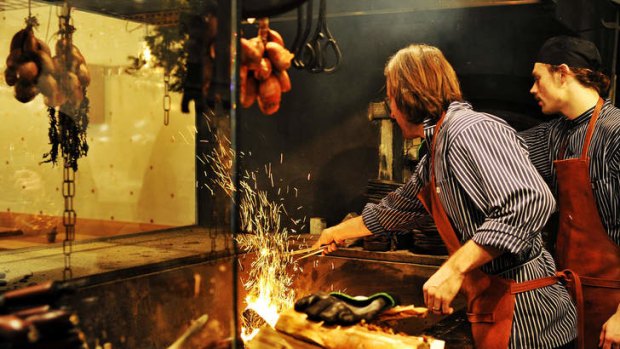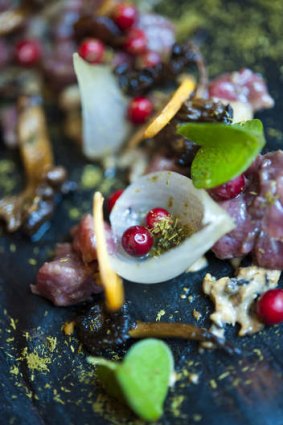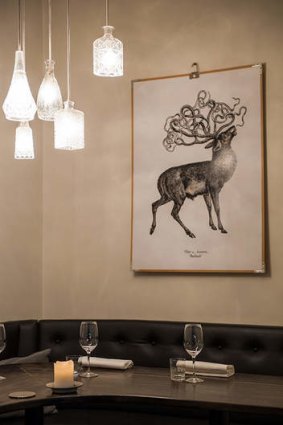
Chefs at work at Ekstedt.
Local, seasonal, sustainable: Leisa Tyler rubs shoulders with Stockholm chefs happy to reintroduce the moose.
The world is having a Swede-centric moment. Retail giants Ikea and H&M are seducing our wallets, and author Stieg Larsson and his penning pals have turned their country into the crime-scene capital of the world. It's Stockholm, I am told, Sweden's ever-confident and socialist capital set on a jigsaw of 14 islands, that is in the vanguard of the trend, particularly when it comes to hotels, museums and restaurants.
After years of looking to the rest of Europe for inspiration, Swedish hoteliers, curators and chefs have turned inwards, rediscovering the products and produce of their country and reinventing them for a new, and positively gleaming, future.

The restaurant's smoked-beef tartare.
Sophisticated but unpretentious is how Jeanette Mix describes her stunning new hotel, Ett Hem. Designed by British-based Ilse Crawford, the former office block in the upmarket neighbourhood of Larkstan is Stockholm's latest lodge offering, and it epitomises the city's smooth confidence and unflinching style. "We just didn't want it to feel like a hotel," Mix says of the 12-room hotel.
"'Ett Hem' means 'a home' in Swedish, and the hotel has oak parquet floors, lime-green felt furniture with charcoal sheepskin throws, and old-fashioned farmhouse tables. The goal was to create a comfortable and elegant space for travellers while keeping service and furnishings at a level found in top hotels."
Street signs are deliberately absent, as are front-door keys; instead, a team of chirpy, professional staff is there to cater to your every whim, including opening the door at 2am, last-minute ironing requests, or roasting a pig for your lunch. There's a fully stocked library as well as a grand piano, and a fridge stocked with wine and snacks guests help themselves to. Hotel Skeppsholmen keeps to a more traditional hotel format, but with Swedish elements throughout. Housed in a pair of 17th-century-built military buildings on leafy Skeppsholmen Island, the 81-room hotel designed by Stockholm-based architectural firm Claesson Koivisto Rune matches clean Scandinavian lines with the original floorboards, worn-stone staircases, and shuttered windows overlooking the water. Swish uniforms worn by staff are by the local label ACNE, the signature scent by Byredo Parfums and the restaurant menu by chef Magnus Johansson, who works with local farmers to produce dishes such as Swedish dumplings with porcini mushrooms, mature cheese and pickled carrots, and sensational breakfasts of pickled herring and freshly smoked salmon with a radish and dill sauce piled onto thick slabs of elastic and tangy sourdough bread.

Restaurang Volt.Credit: Leisa Tyler
From Hotel Skeppsholmen, it's just a hop and a skip by ferry to a clutch of new museums. Stockholm has its share of awe-inspiring exhibitions, including the humbling hulk of the 17th-century warship Vasa, the most cutting-edge and intimidating of its time, which dropped to the bottom of Stockholm's bay after sailing less than a nautical mile into its maiden voyage to war with Poland.
But few places are as much fun as the Spritmuseum, which opened in May 2012, in 18th-century-built former ships' warehouses on Djurgorden Island. Displays here include a consideration of the country's love-hate relationship with alcohol - from the days of prohibition when ration books kept track of consumption, to cultural associations good, bad and ugly through the seasons. Don't miss the Spritmuseum's Absolut Art Collection; 850 pieces of art created by 550 artists including Andy Warhol, Damien Hirst and Helmut Newton for former Swedish vodka company Absolut.
Its seems fitting that the country that gave us Hasselblad should have a state-of-the-art photography museum. Housed in an early 19th- century art nouveau building, the sleek 2500-square-metre Fotografiska museum is one of the biggest photo galleries in the world. The space has already hosted Sally Mann, an American photographer whose black-and-white images of her naked children and dying husband caused as much controversy as they did praise. Up next is David LaChapelle's Burning Beauty, which challenges ideas of consumerism in society (on until March 3, 2013). A museum dedicated to Sweden's best-known export, Abba, will open in the 2013 European spring. Designed by Stockholm-based star architect Johan Celsing, the museum on Djurgarden Island will showcase memorabilia and costumes. The group sold more than 400 million albums worldwide; museum visitors will have the chance to pose with life-size holograms of band members Bjorn, Benny, Agnetha and Anni-Frid.
Nowhere is Sweden's new dynamism more apparent than in its restaurant scene, featuring the buoyant, verging on phenomenal, movement in new Nordic cuisine. Short summers and long winters means the Swedes have a rich culinary tradition of pickling, salting and preserving foods from forests and oceans. But the nation has not been a leader in the art of restaurant dining.
"Ten years ago dining out usually meant eating French or Italian food," says Per Styregard, the editor-in-chief of The White Guide, Sweden's culinary bible. Then change began. Perhaps spurred by the trailblazing kitchen of Rene Redzepi at Copenhagen's Noma in neighbouring Denmark, or perhaps by the latest catchphrases in the culinary world - local, seasonal, sustainable - Swedish chefs have since turned their focus to rediscovering Viking-era staples such as chickweed, Arctic brambles, moose and reindeer, teaming them with cutting-edge techniques in the kitchen.
"We are reinventing our kitchen," affirms chef Johansson. The government's tourism agency, Visit Sweden, agrees: it recently rebranded its campaign to "Sweden - the New Culinary Nation". High on Styregard and The White Guide's list, as well as taking the No.20 spot on Restaurant magazine's world's 50 best restaurants, is Frantzen/Lindeberg, a cosy 17-seat eatery tucked in a ground-floor shop space on historical Stadsholmen Island, a few doors down from the Royal Palace.
Headed by Bjorn Frantzen on savoury dishes and Daniel Lindeberg on desserts, Frantzen/Lindeberg is best known for off-the-cuff cooking techniques and wild pairings using ingredients almost entirely grown by two local farmers. "Bjorn and Daniel are really pushing the boundaries of food," Styregard tells me.
My meal there gets off to a roaring start, with a delicate platter of five "snacks", each thoughtful, artistic and matched with natural champagne. There is a delicately nutty pig's liver, ever so slightly seared Kobe beef topped with a tangle of forest moss, and a sugary carrot macaron. The raw langoustine plucked from the West Coast town of Fjallbacka and prepared 10 minutes before being brought to the table and served with pig's fat, celery and Granny Smith apple foam, is extraordinarily well balanced. The emulsion of scallop with brown butter sauce is just plain delicious. But then the meal changes pace, and Frantzen and Lindeberg's riotous pairings start to surface. I don't mind the medley of odd textures that a cockscomb, monk fish and hazelnuts form, but the succulent lamb steak croaks under the weight of pungent anchovies. Then there's the pungent fermented garlic and dried pig's blood with blackberries, served for dessert.
Chef Niklas Ekstedt huffs at the thought of dainty dishes and mad pairings.
"That's not real cooking," he says with a cheeky grin. Tired of laboratory-style kitchens and high-tech gadgetry, for his latest restaurant, simply called Ekstedt, the former TV chef has gone back to basics, using an open-pit fire, a cast-iron combustion stove for slow cooking, and a wood-fired oven in his electricity-free "Stone Age" kitchen. Here, chefs grapple with blackened tongs longer than their arms and strings of sausages smoking on a resting rack, and churn out hearty, old-fashioned dishes made from Swedish produce. A robust and tasty turbot is cooked in hay and served with squid fried with bread and leek. The smoked-beef tartare with chanterelle (black trumpet) and tarty lingonberries, served on a plate fashioned from a piece of burnt wood, is extraordinarily rich and flavoursome.
It wasn't always thus: the chef and owner of the currently closed Oaxen Krog, Magnus Ek, defied the odds 17 years ago when he opened a fine-dining restaurant on an obscure island named Oaxen, an hour's drive from Stockholm, and started serving haute cuisine with fish caught in the waters surrounding the island, herbs from the garden and vegetables from local biodynamic farmers. "We had a horrible time trying to convince people that local ingredients could be just as wonderful as imported ones," Ek says. "Back then, if you wanted to be fine dining, all you had to do was offer foie gras and caviar. Now, every second restaurant offers seasonal Swedish ingredients.
"Competition is getting tough."
Ek and I are slowly making our way through the cornucopia of cured and dried meats on offer at Oaxen Skafferi, a charcuterie Ek recently opened on Stockholm's Sodermalm island. We try slathers of moose (vivacious, with a hint of liver), reindeer (deliciously smoky and salty), baked and smoked veal tongue (smooth and tender), smoked lard (which Ek insists is good for me), and an extraordinary cured veal, all prepared by Ek and his staff and to be the cornerstone of the new Oaxen Krog, to open in a former shipping warehouse on Djurgarden in 2013.
For now, Ek's eatery of choice is Restaurang Volt, a stylish but unfussy place in the central Ostermalm district, where local and seasonal produce is teamed with what its four young tattooed owners call "grandma flavours" - cooking styles and tastes familiar to their grandmothers. The menu here blends game meats and shellfish with tart forest berries and herbs, serving dishes such as duck breast with sea buckthorn, and rare venison with tangy juniper berries. The ingredients and flavours are distinctly Swedish.
Four other world cities having a moment
SINGAPORE
The city's restaurant scene is hitting the spotlight, with a string of celebrity chefs opening new outlets, including French super-chef Joel Robuchon, British kitchen king Jason Atherton and Australia's Tetsuya Wakuda.
ISTANBUL
This heaving metropolis spanning two continents and seven hills is one of the world's most enchanting and cultural cities. A slew of new museums and sleek heritage hotels are turning out yet another chapter. This one is titled "Istanbul the cool".
ABU DHABI
What do you get when you combine bucketloads of oil wealth and a desire to be the cultural heart of the Arabic world? The city's clutch of new hotels, a Ferrari World theme park and hosting the formula one race, for starters. Soon to come: a Louvre and Guggenheim on Saadiyat Island.
BANGKOK
The city's lodging scene just keeps getting stronger. This year saw the opening of Accor's Sofitel So hotel, the Bill Bensley-designed Siam and a slick hotel by Japanese brand Okura. Up next: a new W Hotel.
FAST FACTS
Getting there Finnair flies to Stockholm for about $1690 low-season return from Sydney and Melbourne, including taxes. Fly to Hong Kong (about 9hr), then Helsinki (11hr), then Stockholm (1hr). See finnair.com.
Staying there
Ett Hem has double rooms from 3800 krona ($550) a night, including breakfast. See etthemstockholm.se.
Hotel Skeppsholmen has double rooms from 1795 krona a night, including breakfast. See hotelskeppsholmen.com.
While there
Fotografiska is open daily. See fotografiska.eu.
Sprit Museum is open daily, 10am-6pm (8pm on Wednesdays). See spritmuseum.se.
Eating there
Frantzen/Lindeberg offers 17-course dinner menus for 2100 krona, Tuesday to Saturday; see frantzen-lindeberg.com.
Oaxen Skafferi is open Tuesday to Saturday; see oaxenskafferi.se.
Restaurang Volt has main courses for 300 krona; four-course menus 550 krona. Dinner Tuesday to Saturday. See restaurangvolt.se.
Ekstedt has five-course menus for 550 krona. Open for dinner Tuesday to Saturday. See ekstedt.nu.
Leisa Tyler travelled courtesy of Finnair and Visit Sweden.
Sign up for the Traveller Deals newsletter
Get exclusive travel deals delivered straight to your inbox. Sign up now.